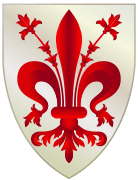Villa La Pietra
| Villa La Pietra | |
|---|---|
|
The Baroque façade of the villa | |
| General information | |
| Address | via Bolognese 120 |
| Town or city | Florence |
| Country | Italy |
| Coordinates | 43°47′45″N 11°15′58″E / 43.79583°N 11.26611°ECoordinates: 43°47′45″N 11°15′58″E / 43.79583°N 11.26611°E |
| Owner | New York University |
| Website | |
|
www | |
Villa La Pietra is a renaissance villa in the hills outside Florence, in Tuscany in central Italy. It was formerly the home of Arthur Acton and later of his son Harold Acton, on whose death in 1994 it was bequeathed to New York University.[1]:18 The villa is now home to NYU Florence.
History
Villa La Pietra was bought and somewhat modified in the 1460s by the Florentine banker Francesco Sassetti.[2] In 1545[3] or 1546[2] it was sold to the Capponi family. The villa was given its present form in the seventeenth century by the cardinal Luigi Capponi, possibly with the assistance of Carlo Fontana. During the brief period from 1865 to 1871 when Florence was capital of the Kingdom of Italy, the villa was used as the embassy of Prussia.[2]
In 1903 Arthur Acton, an Anglo-Neapolitan art dealer, rented it after his marriage to Hortense Mitchell, the daughter of a banker from Chicago, Illinois, William Mitchell. With money from her family, the couple bought the villa in 1907.[1]:22
The villa contains the art collection assembled by the Actons, which reflects twentieth-century Anglo-American taste. It is used for didactic purposes by New York University.[4] The collection includes works from the circle of Giotto, Romanesque sculptures, a relief of the Virgin and Child by Donatello, and fifteenth-century tapestries made for the de' Medici family.[5]
Between 1905 and 1930 the gardens of the villa were substantially altered by the Actons,[2][6]:28 only the walled lemon garden to the north-west of the villa remaining mostly unchanged since the time of Luigi Capponi.[7]:109 The Actons laid out a formal Baroque Italian garden with extensive stonework, including almost two hundred statues, many of them by the Venetian sculptors Orazio Marinali and Antonio Bonazza, brought to Florence from the villas of the Brenta.[2][6]:28 The gardens were restored in the early years of the twenty-first century.[8]
References
- 1 2 A. Richard Turner, Carol A. Mandel (2002). La Pietra : Florence, a Family, and a Villa. Milan, Italy: Edizioni Olivares for New York University. ISBN 888598262X.
- 1 2 3 4 5 Villa La Pietra. Regione Toscana. Archived 17 November 2014.
- ↑ The History of La Pietra. New York University. Archived 1 February 2005.
- ↑ Collezione Acton - Villa La Pietra (in Italian). Ministero dei beni e delle attività culturali e del turismo. Accessed August 2015.
- ↑ William H. Honan (1 March 1994). Plucking a Treasure From Tuscany's Groves; A Historian's Legacy to New York University Is a Life, and Villa, Devoted to Art. New York Times. Accessed August 2015.
- 1 2 Charles Quest-Ritson (2007). Gardens of Europe: A Traveller's Guide. Woodbridge, Suffolk: Garden Art Press. ISBN 9781870673556.
- ↑ Helena Attlee, Alex Ramsay, David Joyce (1989). Italian Gardens: A Visitor's Guide. London: McCarta. ISBN 9781853651823.
- ↑ James Owen (27 May 2008). Villa La Pietra: An English Gardener in Florence. The Telegraph.
![]() Media related to Villa la Pietra (category) at Wikimedia Commons
Media related to Villa la Pietra (category) at Wikimedia Commons
